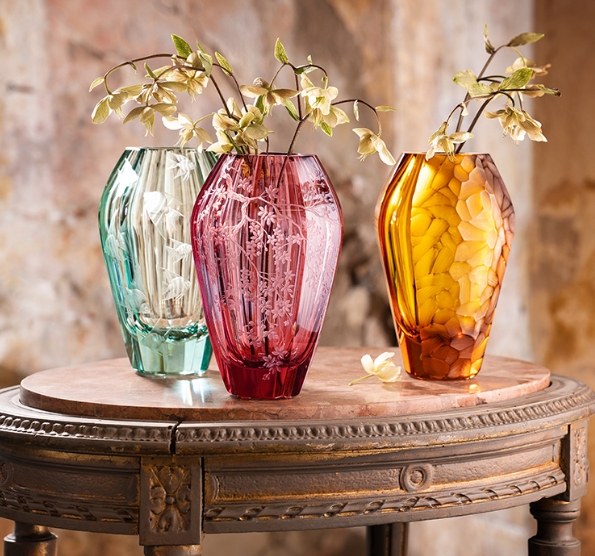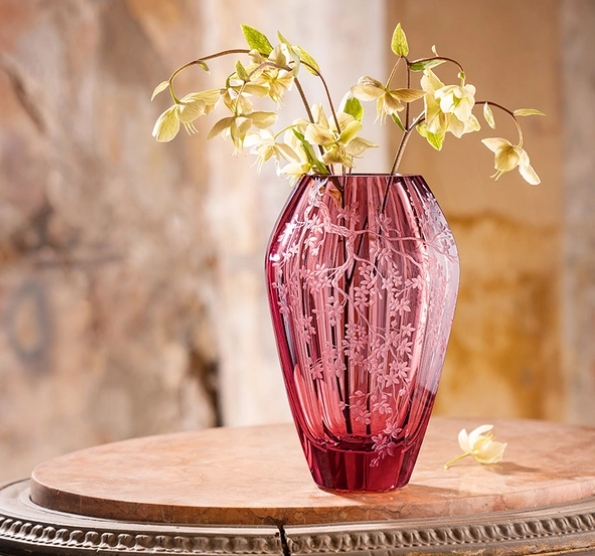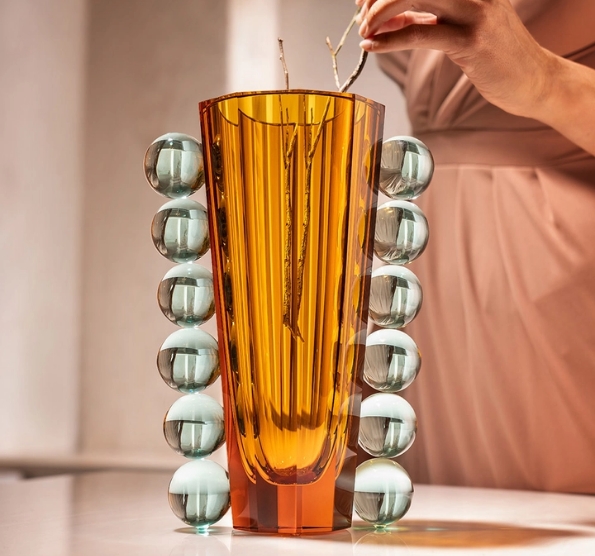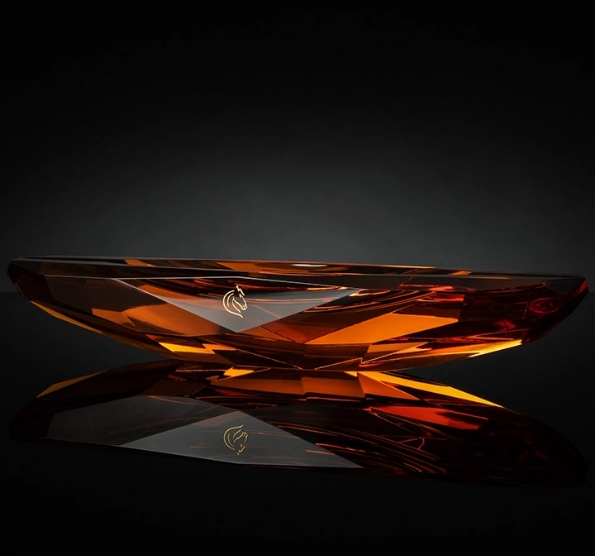Breadcrumbs navigation
- Home page
- About Moser
- Blog
- THE AWARD IS AS AN ACKNOWLEDGEMENT OF THE ENGRAVING CRAFT

THE AWARD IS AS AN ACKNOWLEDGEMENT OF THE ENGRAVING CRAFT
Having joined the “Star Club” literally overnight and currently he goes from one interview to another.
In fact, for us at Moser glassworks, where his career started 26 years ago, and for his customers, he’s already a long-term celebrity. A Knight and Moser master engraver Tomas Lesser, nevertheless, he doesn’t see himself as one and the place where he feels most at home is his workshop.
IT’S BEEN SEVERAL DAYS ONLY SINCE YOU WERE AWARDED. HOW DOES IT FEEL TO BECOME A FRENCH KNIGHT?
To be honest, I didn’t actually become a French Knight, but a Knight for the Oder of Arts and Letters. And the feelings? When I learned the news, it was a huge surprise for me, and it came out of the blue. Someone from the French Embassy in Prague called me and I have to admit that I didn’t believe it first. I googled the award to learn more about it. The laureates from the past indeed make a starful sky together. I was still suspicious until the certificate arrived saying that I was knighted together with official thanks from the French Minister of Culture. That was a stunning moment for sure. The nearer the official ceremony got, the more nervous I became as I knew what awaited me. However, everything changed on arrival in Paris. I realised that there was nothing to worry about, quite the contrary – a great atmosphere and very nice people. I enjoyed the day very much as such.
THIS YEAR, THE LAUREATES MADE A REALLY INTERESTING GROUP TOGETHER. AMONG OTHER KNIGHTS AND KNIGHTESSES WERE CRAFTSMEN FROM LEADING LUXURY BRANDS, SUCH AS CHRISTIAN DIOR, HERMÉS OR LOUIS VUITTON. THEREFORE, MOSER GLASSWORKS WERE IN VERY PRESTIGIOUS COMPANY …
Moser has already been among the European members of Comité Colbert, the French association representing top luxury brands (in 2011, the Comité Colbert opened for non-French companies and Moser became one of the six brands selected – ed. note). Just before the ceremony, we were told that this year, the Order was awarded to foreign craftsmen from these companies for the first time. That’s why I take it more as an acknowledgement of the engraving craft as such.
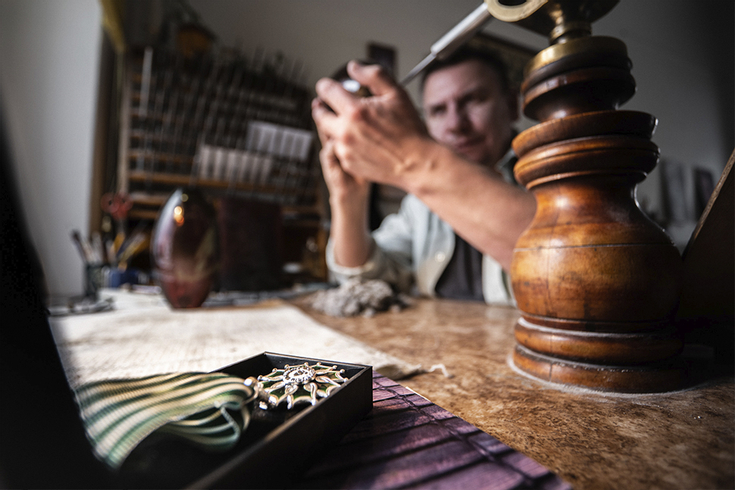
I’VE HEARD YOUR MUM ACCOMPANIED YOU. I CAN IMAGINE SHE WAS IMMENSELY PROUD…
I got divorced recently, so my mum was the first choice, of course. Yes, both of my parents are very proud, without doubt. They boast about my success wherever they go now.
ALSO, SEEING OTHER CZECH LAUREATES OF THE ORDER AWARDED IN THE PAST, I HAVE TO SAY IT IS MORE THAN INTERESTING LIST. THE ILLUSTRATOR ADOLF BORN, SINGER MAGDALENA KOZENA, PHOTOGRAPHER JAN SAUDEK OR FILM DIRECTOR JIRI MENZEL…AND, AMONG THEM, TOMAS LESSER.
(laughs out loud) There is also one other glass artist, Borek Sipek, another important name. But no one from Jenisov, the Czech Republic, as I’m …a guy that no one knows. Well, we know each other in the trade, that’s for sure, but…
STARTING FROM THE VERY BEGINNING – HOW AND WHY DID YOU START ENGRAVING YEARS AGO?
It all started with a children’s festival named after Ota Hofman in Ostrov, CZ. They organised an art competition when I was still in nursery school. I found myself among the three best ones and the diploma I received prompted my parents to send me to a free-time art club. I quite liked the creativity and let’s say…. I wasn’t bad at it. As I grew older, I was noticed by the academic painter Frantisek Tumpach, quite a famous local craftsman, who recommended that I apply at the oldest glassmaking school in Kamenicky Senov, where he himself graduated. However, it wasn’t that easy, as the school system during the Communist regime was based on the work of career counsellors, everything was planned according to statistics and tables, and the idea of a kid going to study to a school at the other side of the country was unthinkable. Furthermore, I was told my grades weren’t good enough and that I wouldn’t even pass the entrance examinations. Fortunately, I was allowed to sit the talent tests and I took first place. That’s why I was eventually taken in. The school offered four subjects: glass engraver, cutter, painter and glass lightening designer. Having gone through the workshops, I wasn’t allured much by cutting, I saw it as a king of a rough work. Glass painting was, on the contrary, a girl’s job in my eyes, and the light design was all about maths and electronics. Engraving seemed the right thing for me. On the top of that, two guys – twin brothers from my hometown, had been already studying it. They grabbed me and said: You’ll be an engraver, that’s that! I had studied for four years and, after graduation, Moser was a clear choice. I also tried the exams at the Academy of Arts, Architecture and Design in Prague, but that was a miss as I chose a wrong field: book graphics and calligraphy, one with very high competition. Therefore, I gave up and decided to go to work in the glassworks. High school was originally only the starting point, as I saw it. However, in the end, I don’t regret anything.
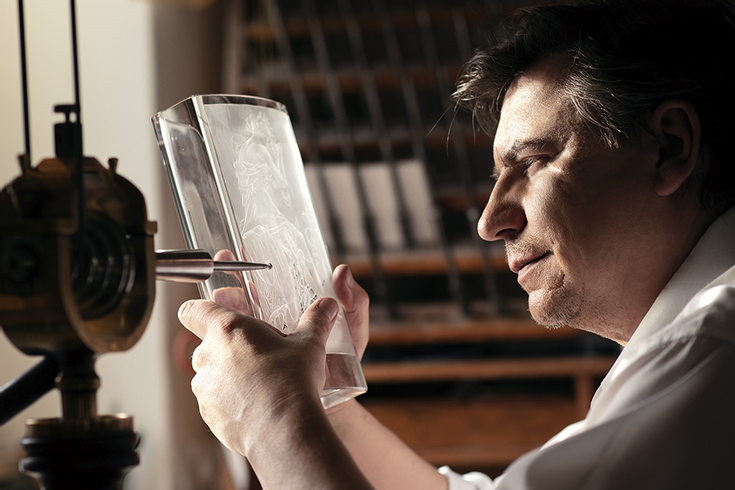
WOULD YOU CHOOSE THE SAME NOW?
Why not (laughs). The beginnings in Moser were tough, as it would be for any novice in the workshop. You have to start from the fundamentals, learn everything from scratch. Moser was, in this sense, more than the actual school, where I learned to draw etc., rather than the rules of the craft as such. The first few years in the glassworks, I engraved drinking sets, such as Maharani and Rose, mainly…Maharani, Rose, Maharani…simple crystal sets. Obviously, I began to hate the repetition. For a young student, getting up early and commuting from Ostrov to Karlovy Vary was difficult of course. You can imagine, I was a Bohemian, head full of ideals, and suddenly I had to be on time at 6:00 AM and use a clock. Nothing for me. However, you get used to anything and I stopped minding it later on. Master engraver Skala then started to give me more complex tasks as he noticed that, in my free time, I’m trying to do my own stuff. I gradually found myself doing more and more difficult jobs, and, in the end, I reached master objects. It took many years, however – my first serious work, came after approximately five years. Usually, I set some goal, for example Maria Theresia 801, and I told myself: If I’m able to do this one day, I’ll know that I’ve learned something.
SOUNDS LIKE MOVING UP LEVELS IN A COMPUTER GAME…
Levels, exactly. My next level is authorial work, something of my own design.
YOU’VE NOT DONE YOUR OWN DESIGN BY NOW?
I have, but those have been mainly commercial things as we always have to think and plan economically to be able to sell the pieces. That’s why I can’t simply come with my own experiments. I have many inspirations and ideas in head, but those would find one customer at maximum.
OF COURSE, THE GLASS PIECES HAVE TO FIT IN THE OVERALL PORTFOLIO…
Exactly. For example, “the Peacock” or “the Butterfly” are my ideas and designs, but they’re both in tune with the rest of our offer.
DO YOU WORK ON SOME AUTHORIAL ENGRAVING RIGHT NOW?
Well, I draw sketches all the time and, of course, I also have and engraving machine at home in my garage. I use it mainly for friends and family presents though.
SO, ENGRAVING AT WORK ISN’T ENOUGH FOR YOU, YOU DO SOME MORE AT HOME IN THE GARAGE…
(laughs) It isn’t on a daily basis. (some more laughter) I’m not that much of a nerd.
ONLY AT WEEKENDS THEN?
No, I rather go to pub with friends at the weekend. The main thing is engraving requires lots of time. One has to keep learning and you can never say you’re done with it – you still need to strive for progress and improvement.
EVERYONE IN MOSER ACTUALLY SAYS SO. ISN’T THAT TOO MUCH MODESTY?
It sounds like a cliché, but it’s actually extremely true.
ARE THERE ACTUALLY THINGS YOU STILL HAVE TO THINK ABOUT HOW TO DO?
Definitely, that’s why I like limited collections of one or two pieces. When there is too many of them, the product loses charm for me. For example, “the Peacock” is made in hundreds. After fifth or sixth, I already know all the perks and it ceases to be a challenge for me. Still, of course, each piece has to be done 100%, but in general – the first try is interesting, you’re testing the limits, and around the third one should be the best. The twentieth then becomes a bit boring for me. Everyone feels different about it though, this is just my feeling.
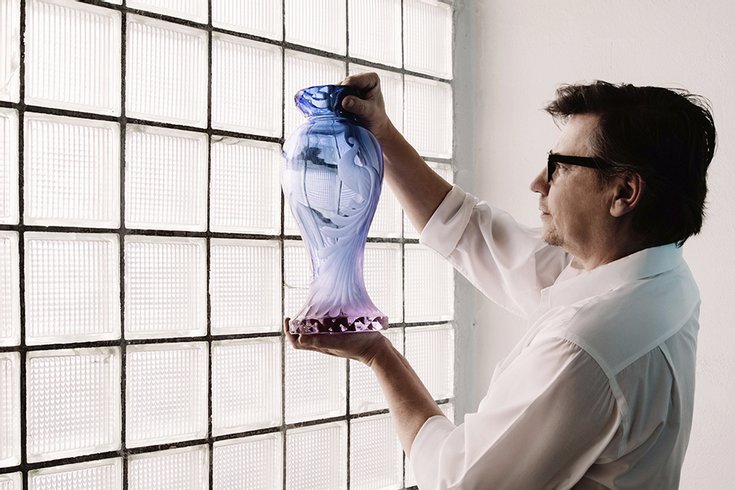
DOES IT TAKE ABOUT FIVE YEARS THEN TO GAIN CERTAINTY IN THE CRAFT?
More or less. I wouldn’t place any certainty on that. It just took me five years to get to some more complex work. Everyone needs to start from scratch, to learn the basic cuts. I learned the fundamentals by engraving Moser Maharani drinking set. This particular type of engraving involves almost all aspects, curves and lines…to be able to make a circle…and when you begin to do some bigger pieces, you start using larger discs. Once you’re uncertain, you take smaller ones as you’re cautious about making a mistake – an overcut. The more experience you have, the bigger discs you choose.
HOW LONG HAD IT TAKEN FOR YOU TO BECOME A MASTER?
The word master…is used, but a master is basically the leader of the workshop. One becomes a master (in the sense of Mastership) when someone starts calling him so. I won’t ever call myself master.
WHEN DID THE OTHERS START CALLING YOU A MASTER?
I don’t actually remember, but they do so from time to time. There have been many talented engravers around me, many of them have retired already. I’m a bit ashamed with those as they did the job for around forty or fifty years.
YOU HAVE ALREADY MENTIONED VLADIMIR SKALA. IS HE YOUR MAIN MENTOR?
He taught me the basics of the craft for sure. He’s truly dedicated, he breathes Moser. It’s him, who allowed me to try more complex work. He’s always been allocating the tasks and upon seeing someone was ready for a challenge, he gave it to him. I’m extremely grateful to him for that.
WHAT ARE YOUR FAVOURITE PIECES FROM MOSER PORTFOLIO?
There are more of them. I love figural engravings, I’m not that much into fauna actually. My thing is figural stuff, such as Mucha’s Art Nouveau, or Botticelli, “Three Graces”, “Birth of the Venus”. I always choose a motif and simply hope I manage. It has to be suitable for a particular type of glass, it has to be workable. I can’t do extensive engraving all over a rounded vase as it wouldn’t be seen in the end.
DO YOU SEARCH FOR MOTIVES YOURSELF THEN?
Lots of them have been done here in Moser for many years. A long time ago, for example, someone made the first pieces with “Three Graces” by Botticelli. Then, someone orders it and therefore, from time to time, I have a chance to make it. We also have a big client from Taiwan, for whom we make a new collection every year. Each engraver in the team can come with suggestions for a design. Usually, it’s thematically given. Last year it was Antiquity, this one it’s Renaissance. I search for a suitable motif I like and when I think it could fit in and be successful with the client, I present it to the board with our creative director as the head. We discuss it and they give me their recommendations. Then there are cases, when they give me a free reign, just as with “the Peacock”. It has become a huge success in spite of the fact it’s a relatively simple thing, no complex anatomy or anything. It just very much fits the shape of the vase. In the end then, it’s about such pieces because, of course, the glassworks need customers and sales to be successful.
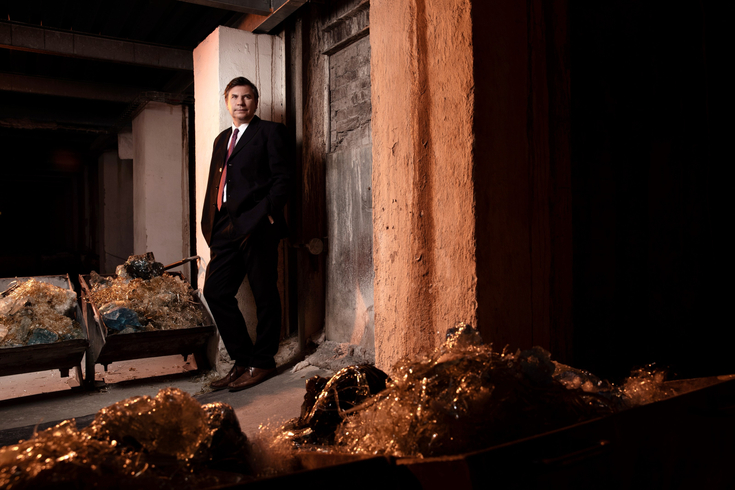
WHAT KIND OF ENGRAVINGS TAKE THE MOST TIME?
Figural motives for sure. The more detail there is, the more complex it is both art and time wise. Some vases can take up to month and a half. Also, I can’t say that all engraving always takes exactly the same time. No two pieces are identical. When you place two of my vases with the same motif next to each other, you always spot differences. That’s the magic of handmade products – it’s not done by robots and machines. All those little imperfections are actually beautiful. I’m not talking about a sloppy job, just the way you can see it has human touch to it.
SO, WHEN YOUR HAND SLIPS, YOU CAN SAY...(LAUGHTER)
…that it was an intention (chuckles). Some mistakes can be corrected, some can be explained. The older and more experienced you’re the less they should occur, however.
DOES IT HAPPEN THAT YOU MAKE A MISTAKE TO AN EXTENT THAT THE WHOLE VASE HAS TO BE THROWN AWAY?
It doesn’t, and it actually shouldn’t happen with large objects. It has never happened to me at least. Such things can occur with glasses that have some curves at the rim and it recoils – even a master cam sometimes make a mistake, as we say. With small glasses, the loss isn’t that big. It’s the worst when you’re done, and it breaks with polishing. Of course, it comes up more often for beginners, but from certain level, it indeed shouldn’t.
YOU MUST BE VERY PATIENT TO SPEND SO MUCH TIME WITH EACH PIECE…
For sure, patience, a steady hand and good eye are necessary. Muscles are needed as well, some of the vases are really heavy. When you hold 4-5 kilograms in your hands for several hours, tiny details can become a problem – to stay focused and target well.
HOW LONG CAN YOU ACTUALLY KEEP WORKING WITHOUT A BREAK? DO YOU HAVE TO GO FOR A WALK IN SOME INTERVALS OR DO SOME EXERCISE?
That’s very individual. It also depends on a particular day – for example, sleeping is important. At certain moments you have to put the vase aside to change a disc, and that gives space for some rest. However, no one can do eight hours in a row with a heavy vase in their hands. Breaks are essential, but I don’t need an hour break after an hour working, that’s not so.
YOUR JOB GIVES YOU LOTS OF OPPORTUNITIES FOR TRAVEL AND PRESENTING YOUR ART FOR MOSER ALL OVER THE WORLD. DO REACTIONS DIFFER WITH REGIONS – FOR EXAMPLE EUROPEAN FROM THOSE IN ASIA?
I would say so. We go to Asia quite often – Japan, China, Hongkong, Taiwan. People in these places a very interested in it and they admire any handmade products. One cut is enough to make them excited as they see something being born from human hands. That’s why the Asian market is so important for handmade glass. On the other hand, when we go to Russia, we’re perceived as common craftsmen. “Just engrave a letter here for me, that’s nice”… and that’s all, they leave. It feels colder there, but that’s again quite individual. You can’t say that it works like that over there with everyone. However, in general, Asians are more excited and responsive, that’s for sure.
TASTES ARE PROBABLY ALSO DIFFERENT, AREN’T THEY?
I have noticed that in Taiwan, people like European themes – baroque angels, Renoir. European art, in general, is quite exotic for them. The same as when we put bonsais and calligraphies on our walls. In Japan, we did several of their motives, but it wasn’t a hit. Mostly, specific orders come in. The customer wishes for a particular drawing and asks for it. If its plausible, we engrave it, of course. This way, I did, for example, a vase with Istanbul Blue mosque, based on a sent photograph.
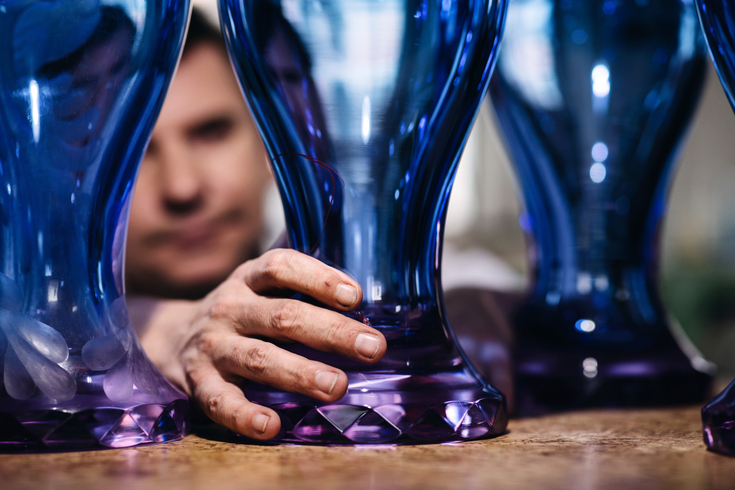
THE INTEREST IN CRAFT HAS BEEN SLOWLY DECLINING, HASN’T IT…IS IT DIFFICULT TO GET YOUNG PEOPLE FOR IT?
That’s very true. Before the ceremony in Paris, we had a short introductory meeting with all the laureates and the leaders of Comité Colbert. They explained the main motivation behind the acknowledgement. Each of us has, of course, achieved some artistic results and it’s always won hard. However, raising interest for handcrafts among young people had also played an important role as they’re getting less and less attention nowadays. It’s different to be an actor or a craftsman. Comité Colbert aims to raise the knowledge to such a level, that a potentially interested person had a clear idea of the possibilities that they can reach. It’s a brilliant idea. The main problem is – and I know it from my own experience, that at glass making school, people mainly learn about art, design and creativity, and the moment they come to the glassworks, they find out it’s also very tough job that takes time to progress in. Therefore, young people tend to go elsewhere, or further university. I studied in a group of nine people and I’m the only one who makes living from glassmaking.
DO YOU WORRY ABOUT THE FUTURE OF CRAFT?
I’m a bit worried. The craft is, nevertheless, so interesting, that there will always be someone getting involved. It’s quite an exotic thing. In my case, I chose it because I saw it as an opportunity to break through. Nowadays, almost anyone can be a painter, but with glass, there’s not that much competition.
HOW DO YOU RELAX? I HAVE READ ABOUT YOUR HOBBIES…CHOIR SINGING, PAINTING AND FISHING, IS IT TRUE?
I don’t do choir singing anymore, it was only for five years. The same with fishing, recently it has become quite an expensive hobby. Painting is still my hobby, that’s true. I do mainly portraits and figures. Also, I bought drums and I practise in my living room. That is a way of relaxing for me. Last, but not least, I have a dog and a tomcat. We’re three guys in the house. (laughs)



